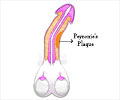The act of sex may be nearly as old as animal life itself, at least that’s what the new discovery suggests. According to scientists, the first creature who enjoyed a romp did it 570 million years ago and was 12 inches long.
Fossils of a long, thin rope-like creature, called Funisia dorothea, standing erect on the sea floor suggest that they were at it 30million years before anyone else, scientists say.“We are seeing possibly the very first instance of sexual reproduction in animals on our planet,” The Sun quoted Mary Droser, a professor at the University of California, as saying.
The creatures have been found in what is now the Australian outback.
Expert Rachel Wood, of the University of Edinburgh, said: “Funisia had close-packed growth, allowing us to presume this organism reproduced sexually.”
“This is how many primitive animals, such as sponges and corals, reproduce today,” she added.
The scientists discovered that Earth’s ecosystem has been complex at least since around 565 million years ago, a period which in history is known as the Neoproterozoic era.
Based on a study of ancient fossils excavated in the South Australian outback, the new suggestion is quite contrary to the prevalent belief that the earliest multicellular animals were simple, and that strategies organisms use today to survive, reproduce and grow in numbers have arisen over time due to several factors.
During the study, the researchers observed that Funisia appeared as 30 cm-long tubes in the fossils. They also observed that the tubes commonly occurred in closely-packed groups of five to fifteen individuals, displaying a pattern of propagation that often accompanies animal sexual reproduction.
“In general, individuals of an organism grow close to each other, in part, to ensure reproductive success. In Funisia, we are very likely seeing sexual reproduction in Earth’s early ecosystem – possibly the very first instance of sexual reproduction in animals on our planet,” said Droser, the first author of the research paper.
She added that the clusters of similarly sized individuals of Funisia are strongly suggestive of “spats”, huge numbers of offspring an organism gives birth to at once.
Besides producing spats, say the researchers, the individual tubular organisms reproduced by budding, and grew by adding bits to their tips.
“Among living organisms, spat production results almost always from sexual reproduction and only very rarely from asexual reproduction,” Droser said.
Scientists are of the opinion that a clear picture of the early ecosystem on Earth can help discern how early life evolved, what it looked like, and how organisms respond to environmental and other changes.
“The nature of the early ecosystem also clues us on what to look for on other planets in our search for extraterrestrial life,” Droser said.
The study has been published in the journal Science.
Source-ANI
SRM/S











